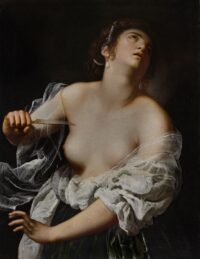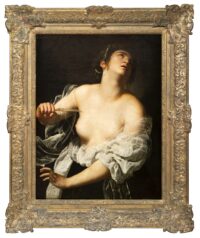 The J. Paul Getty Museum in Los Angeles is the proud new owner of a previously unknown painting by trailblazing Baroque painter Artemisia Gentileschi. It depicts the Roman heroine Lucretia in the moment before she plunges a dagger into her heart. Lucretia, raped by the son of Tarquin, king of Rome, demanded her relatives avenge her honor, then killed herself in front of them. Her act spurred the tyrannicide of Tarquin by Lucius Junius Brutus and the founding of the Roman Republic.
The J. Paul Getty Museum in Los Angeles is the proud new owner of a previously unknown painting by trailblazing Baroque painter Artemisia Gentileschi. It depicts the Roman heroine Lucretia in the moment before she plunges a dagger into her heart. Lucretia, raped by the son of Tarquin, king of Rome, demanded her relatives avenge her honor, then killed herself in front of them. Her act spurred the tyrannicide of Tarquin by Lucius Junius Brutus and the founding of the Roman Republic.
The painting is in exceptional condition, small details like the tears welling up in Lucretia’s eyes still clear and untouched by the passage of centuries, poor storage conditions or misguided restoration attempts. It’s rare for a Baroque era painting to survive in such a pristine state of preservation.
 Lucretia first surfaced in 2019 when it was sold at a Paris auction. The sellers had bought it in Cannes in the 1980s and kept it in their Lyon home for 40 years, unpublished and unknown. There are only about 60 known paintings that can be attributed to Artemisia Gentileschi, and a good half of them cannot be conclusively authenticated as works of her hand, so her paintings are very highly coveted the rare times they come up for auction. Surprisingly absolutely nobody, the rediscovered work blew past the risibly low presale estimate (€600,000 – €800,000) and sold for €4,777,000 ($5.3 million), including the buyer’s premium and taxes.
Lucretia first surfaced in 2019 when it was sold at a Paris auction. The sellers had bought it in Cannes in the 1980s and kept it in their Lyon home for 40 years, unpublished and unknown. There are only about 60 known paintings that can be attributed to Artemisia Gentileschi, and a good half of them cannot be conclusively authenticated as works of her hand, so her paintings are very highly coveted the rare times they come up for auction. Surprisingly absolutely nobody, the rediscovered work blew past the risibly low presale estimate (€600,000 – €800,000) and sold for €4,777,000 ($5.3 million), including the buyer’s premium and taxes.
 The auction experts dated it to between 1630 and 1635, the late part of her career when she lived in Naples. Lucretia’s suicide was a subject she returned to repeatedly in her career. Another from the early years of her life Naples sold at auction in 2018 for $2.2 million. The earliest known Lucretia was painted around 1623-5 when Artemisia lived in Rome. It is now in the private collection of paisley mogul Gerolamo Etro in Milan.
The auction experts dated it to between 1630 and 1635, the late part of her career when she lived in Naples. Lucretia’s suicide was a subject she returned to repeatedly in her career. Another from the early years of her life Naples sold at auction in 2018 for $2.2 million. The earliest known Lucretia was painted around 1623-5 when Artemisia lived in Rome. It is now in the private collection of paisley mogul Gerolamo Etro in Milan.
The Getty’s research indicates the rediscovered Lucretia likely predates her Naples sojourn and was made around 1627 when Artemisia lived in Venice.
There is evidence that Artemisia painted this Lucretia during her time in Venice in the late 1620s. With its swirling and exuberant drapery, and its free brushstrokes, the picture shows the profound engagement with the artistic legacy of 16th-century Venetian painting, especially with the female protagonists of paintings by Titian and Veronese. The painting also reflects Artemisia’s close contact with expatriates active in Venice in the 1620s, such as the French Nicolas Régnier, the German Johann Liss, and the Genoese Bernardo Strozzi.
In 1627, a pamphlet was printed containing a number of poems dedicated to four of Artemisia’s paintings executed in Venice: two on a self-portrait, one each on a Susanna and a Sleeping Cupid, and three on a Lucretia. The author was likely Giovanni Francesco Loredan, one of a close-knit group of writers, artists, musicians, librettists, and patrons who were associated with Artemisia during her Venetian sojourn. It is highly probable that the Getty’s Lucretia is the same painting praised in the poems published in Venice in 1627.
“With the discovery of new documents and the emergence of new paintings, our understanding of Artemisia’s art has become much more complex and nuanced in the last 20 years. This recently rediscovered work sheds a new light on a crucial and hitherto overlooked moment of her career, when the painter is transitioning from the Caravaggism that had been the hallmark of her formative years to a more graceful and idealized manner which will characterize her maturity,” said Davide Gasparotto, senior curator of paintings at the Getty Museum. “Lucretia is a powerful and compelling example of Artemisia’s most significant type of subject, the representation of dynamic female figures which appear in control of their own destiny; but with its lyrical and sophisticated expressivity, its creamy impasto and vibrant brushwork, the painting is also suggestive of new directions in her artistic itinerary”.
The Getty is currently closed due to you know what, but it is expected to reopen in the next few weeks. Lucretia will be on display to welcome visitors when it does.
How exciting! I am only an art aficionado at the most elementary level, but I do know and love Artemisia. What a gorgeous treasure!
Whatever happened to poor ‘Lucretia’ in the 5th century BC, people were possibly also aware of what happened to ‘Lucrezia’, daughter of pope ‘Alexander VI’ Borgia, and particularly her alleged lover, in 1498AD.
In case of Lucrezia, however, it is rumored that she was in possession of a hollow ring that she frequently used to poison opponents :skull:
Also, I learned that I have one of Artemisia’s earliest ‘Susannas’ nearby.
———-
“Tarquin entered Lucretia’s bedroom, quietly going around the slaves who were sleeping at her door. When she awoke, he identified himself and offered her two choices: she could submit to his sexual advances and become his wife and future queen, or he would kill her and one of her slaves and place the bodies together, then claim he had caught her having adulterous sex.”
–vs.–
“During the prolonged process of the annulment of her first marriage, Lucrezia B. allegedly was involved in a scandal involving her alleged relationship with P. Calderón, a Spaniard generally known as ‘Perotto’. His body was found in the Tiber in 1498, along with the body of one of Lucrezia’s ladies. It is likely that her brother Cesare had them killed, as an affair would have damaged the negotiations being conducted for another marriage. Rumors were also spread suggesting that a child born at the time, Giovanni Borgia, a.k.a. the ‘Infans Romanus’ (child of Rome) was Lucrezia’s.”
———-
en.wikipedia.org/wiki/Lucrezia_Borgia#Alleged_affair_with_Perotto
en.wikipedia.org/wiki/Roberto_Calvi#Death